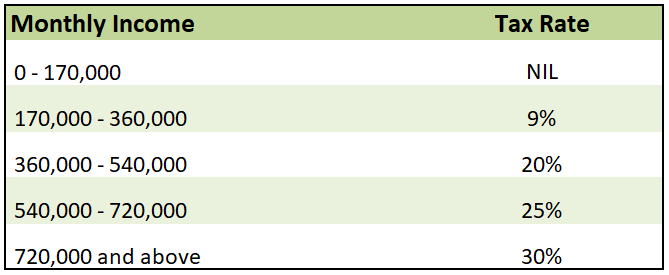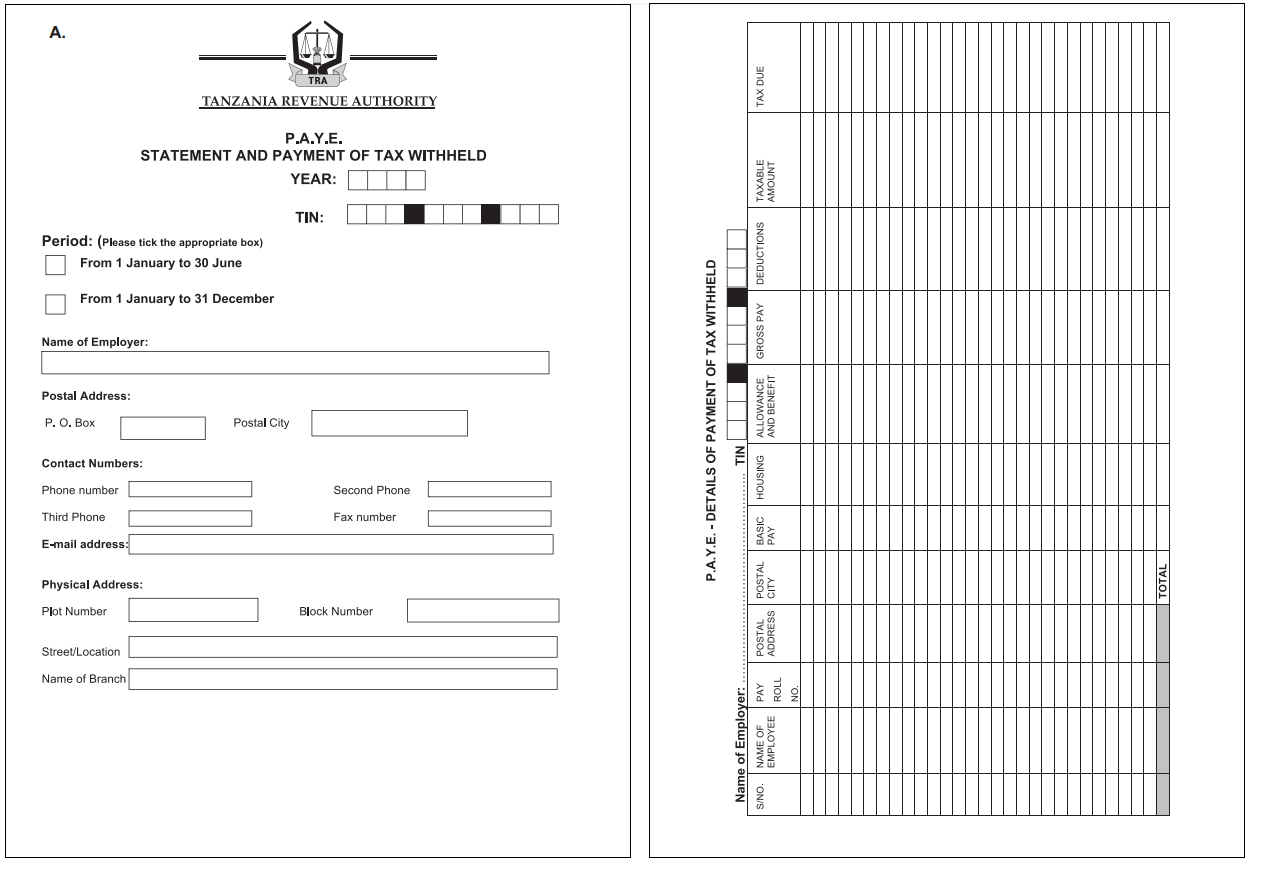What is PAYE (Pay As You Earn)?
PAYE stands for Pay-As-You-Earn. It is a withholding tax on taxable incomes of employees. Under this system, an employer is required by law to deduct income tax from an employee’s taxable salary or wages.
PAYE Calculation Slab
PAYE income tax calculation is based on the tax slab split income wise. It’s a progressive slab system. Employees with higher wages are obliged to pay more than the employees who earn less. The total taxable income of employee is split in brackets as defined in the slab (0-170,000 | 170,000-360,000 etc). Amount applicable in each tax bracket attracts the corresponding percentage of tax and the total is summed at last the tax liable. The current tax slab applicable for PAYE calculation is provided below:

Calculation of PAYE
Download Tanzanian Payroll Software for PAYE calculation!
Benefits In Kind
When an employer provides for personal needs of the employee through providing the employee with goods or services, the use of assets, etc. (as opposed to money) these provisions are benefits in kind. All payments consisting benefits in kind must be included in calculating the employee’s monthly pay and are subject to income tax by withholding. It is the employer’s responsibility to ensure that the tax due on the benefits in kind is withheld from the employee’s cash wages (together with tax due with respect to those cash wages). The value of the benefits in kind is, in general, the market value of the benefit. This means the money that a person would have to pay on the market to receive the same or similar goods, service or other benefit. The amount of the value of the benefit must be included in the monthly pay of the employee (unless it is within the exempt amount). The following special rules apply for calculating the value of the provision of motor vehicles, subsidized loans and housing benefits:
Motor Vehicle
If an employer provides a motor vehicle that is available for the private use of an employee, the private use benefit must be included in calculating the employee’s monthly pay and is subject to income tax by withholding. An exception applies (and the amount is excluded in calculating monthly pay) where the employer does not claim a deduction for expenditure on the motor vehicle in respect of its ownership, maintenance or operation.
Subsidized loans
An employer or associate of the employer may provide a loan to an employee at no interest or at an interest rate that is below the commercial interest rate. In this case, if the loan is for a period of more than a year and the amount of the loan and any other loans to the employee is more than three months of the employee’s basic salary, the benefit of the interest forgone must be included in calculating the employee’s monthly pay. The value of the benefit is equal to the difference between the interest the employee pays (if any) and the amount that would have been paid using the commercial interest rate.
Provision of housing
The value of housing provided to an employee by the employer is a taxable benefit and should be included in the employee’s monthly pay. The value of housing is calculated as the market value of renting the house or 15% of the rest of the employee’s income from the employment, whichever is less. However, if the employer claims a deduction greater than the 15% amount with respect to this housing in calculating the employer’s income (e.g. depreciation allowances and maintenance and utility bills), the value of the benefit is the amount of the deduction claimed by the employer or the rental market value, whichever is less.
Tax benefit
Tax benefit occurs when the employer pays tax on behalf of the employee. In this case, the amount of tax paid is treated as benefit in kind in hands of the employee that is tax on tax.
Withholding And Remittance Of Tax
General
The Tax Administration Act 2015 requires an employer to remit tax withheld from his employees within seven days from the end of the month during which the monthly pay is paid. Failure to observe this requirement will render the employer liable to the tax liability with penalty.
REMITTANCE OF TAX
Employers MUST make remittances of tax withheld through banks. The following arrangements refer to remittance through banks:
(i) Remittances are made by use of paying in slips. Remittances must be made with the bank with which the employer maintains an account.
(ii) Pay in slips to be submitted to the TRA Office within the time limit.
(iii) All copies of the paying in-slip should be completed in detail. figures should not be erased or tampered with
(v) Employers must ensure that all the copies of paying in-slips have been stamped and signed by the bank teller or cashier
The Tax Withholding Statement Form ITX215.01.E


Leave A Comment
You must be logged in to post a comment.